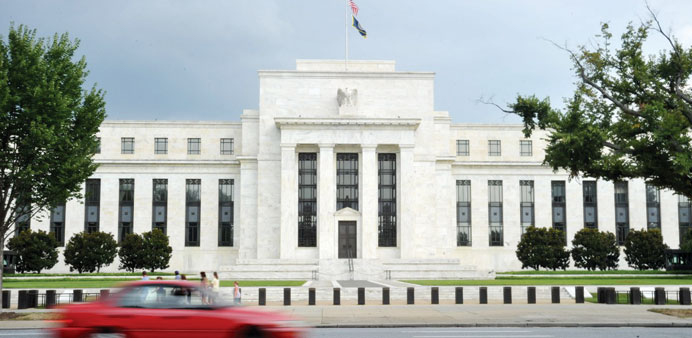The Federal Reserve building in Washington. The blowout US jobs report for October means the Fed may be weeks away from raising interest rates. For US savers earning next to nothing on $2.6tn of money-market mutual funds, the move will barely register.
Bloomberg
New York
The blowout US jobs report for October means the Federal Reserve may be weeks away from raising interest rates. For US savers earning next to nothing on $2.6tn of money-market mutual funds, the move will barely register.
The reason is that there’s an unprecedented shortfall in the safest assets, especially Treasury bills - a mainstay of those funds and traditionally the government obligations that are most sensitive to changes in Fed policy. The shortage means some key money-market rates will probably remain near historic lows even if the central bank increases its benchmark from near zero next month.
As a share of US government debt, the amount of bills is the lowest since at least 1996, at about 10%, and the Treasury is just beginning to ramp up issuance of the securities after slashing it amid the debt-ceiling impasse. Meanwhile, regulators’ efforts to curb risk after the financial crisis are stoking increased demand: Money-market industry rules set to take effect in October 2016 may lead investors and fund companies to shift as much as $650bn into short-maturity government obligations, according to JPMorgan Chase & Co.
“The demand for high-quality short-term government debt securities is insatiable and there is just not enough supply,” said Jerome Schneider, head of short-term strategies at Newport Beach, California-based Pacific Investment Management Co, which oversees $1.47tn. “Even given the increased bill sales coming as the debt-limit issue has passed, it won’t keep up with rising demand from regulatory forces. This will keep rates low.”
While the US government stands to benefit as the imbalance holds down borrowing costs, it’s proving the bane of savers. Average yields for the biggest money-market funds, which buy a sizable chunk of the $1.3tn Treasury bills market, haven’t topped 0.1% since 2010, according to Crane Data. In 2007, they were above 5% before the Fed started slashing rates to support the economy. With returns this low, investors have less incentive to sock away cash.
The Standard & Poor’s 500 index has earned 3.8% this year, including dividends, according to data compiled by Bloomberg.
Mary Lee Wegner, a 54-year-old Los Angeles lawyer, is among investors eschewing money funds for higher-yielding choices as her financial adviser, Ross Gerber of Gerber Kawasaki, tells her rates will remain low even after the Fed begins tightening.
“The Fed has forced me to become a more willing investor, because if I decided to keep a large portion of my money in savings with the level of inflation and zero interest rates, I’m losing money,” Wegner said. “I don’t have much of a choice but to be less risk averse.” The new rules threaten to roil the industry as much as near-zero interest rates.
Regulators are trying to make money funds more stable after the 2008 collapse of the Reserve Primary Fund, as bets it made on Lehman Brothers Holdings debt soured. The decline in its share price below $1 triggered a run on money funds that contributed to freeze credit markets. The new Securities and Exchange Commission measures, which include redemption fees in times of market stress, apply to so- called prime funds, which can also buy corporate debt such as commercial paper. Under the new regulations, institutional prime funds must have a floating share price.
BlackRock, Federated Investors and Fidelity Investments are among asset managers changing money-fund offerings in response to the shifting rules. They’re converting prime funds to choices focused on government securities, including bills and agency offerings.
Adding to the supply-demand imbalance in bills, higher capital requirements have led some banks to place fees on deposits, pushing savers into short-term government securities.
“There has been tens of billions that has flowed into the government money-market sector, but it’s about to turn into hundreds of billions,” said Peter Crane, president of Crane Data, a Westborough, Massachusetts-based firm that tracks the industry.

